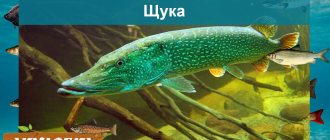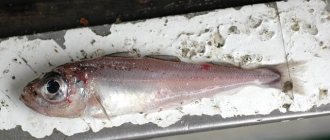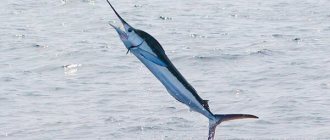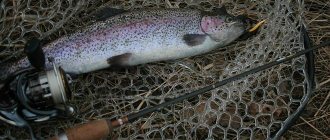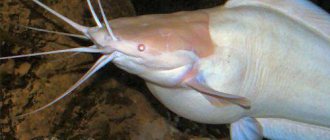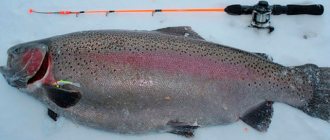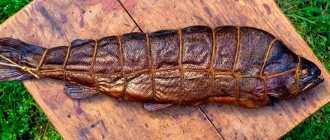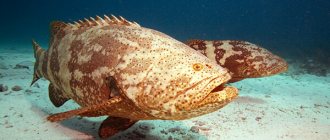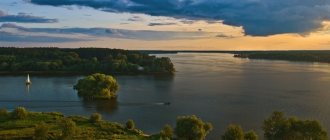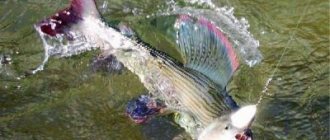Where can I meet?
Where brook trout live, and these are large or very small rivers, transparent and saturated with oxygen. People have been using this feature for its intended purpose for a long time. It can also be found in lowland rivers.
The Kola Peninsula and sea basins are her favorite place in Russia.
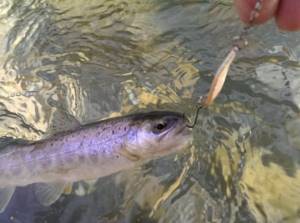
The mountain streams of Western Europe are also inhabited by it. (from Murmansk to the Mediterranean Sea 1500 meters above sea level).
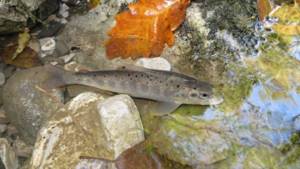
Notes
- Dictionary of foreign words. Ed. Academician of the Academy of Sciences of the URSR A. S. Melnichuk, Second edition, Main editorial office of the URE, Kyiv, 1985.
- K.A.
Savvaitova. TROUT (Black Sea subspecies) - Salmo trutta labrax Pallas, 1811 (anadromous form)
(undefined)
.
Red Book of the Russian Federation
. Access date: January 24, 2011. - N.I.
Shilin. TROUT (subspecies Eizenam trout) - Salmo trutta ezenami Berg, 1948
(undefined)
.
Red Book of the Russian Federation
. Access date: January 24, 2011. - ↑ 1 2 3 Reshetnikov Yu. S., Kotlyar A. N., Rass T. S., Shatunovsky M. I.
Five-language dictionary of animal names. Fish. Latin, Russian, English, German, French. / under the general editorship of academician. V. E. Sokolova. - M.: Rus. lang., 1989. - P. 69. - 12,500 copies. — ISBN 5-200-00237-0. - ↑ 123
Vertebrates of Russia: brown trout
External signs
The color scheme of the fish’s body ranges from yellow to dark gray. The back is a darker, more intense greenish color. The abdomen is white. The head is darker than the body. Two rows of teeth.

It is called “Pestrushka” because it has many small, dense scales. And a huge number of round spots of dark color, with a lighter border.
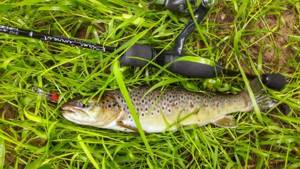
The saturation of color and spots depends on the environment. This includes food, time of year, etc. The spots are often red. And in the photo, the brook trout shimmers with colors.

Living conditions
In good living conditions it becomes 25-55 centimeters long. The weight of an adult is about two kilograms. A two-year-old weighs only half a kilo, and this is if there is enough food, such as in forest rivers.
«>
And if the conditions are as good as possible, then the weight can reach about 12 kilograms, and the meat is red. This red brook trout meat is very valuable. In “poor” living conditions, the meat is white or slightly pink.
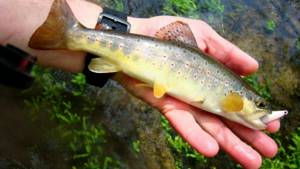
Fishing Features
The brook trout hunting season begins in the spring when the rivers open up. Fish that spawn in late autumn lead a passive lifestyle in winter. In winter, trout move little and eat less. By spring, her body weakens, and she does not leave the wintering place for some time. At this time, the fish live closer to the bottom and feed on food brought by the current: small fish, frogs and burdock larvae.
The effectiveness of fishing largely depends on the choice of fishing location. Trout lives in fast-flowing rivers with a high oxygen content and water temperature no higher than 20˚C. Such rivers are typical for mountainous areas and for places with a large number of springs.
Fishing methods
Trout fishing is done in several ways:
- spinning;
- fly fishing;
- float rod.
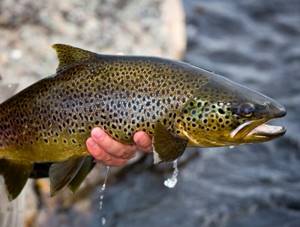
For fishing in the summer season, spinning or fly fishing is more suitable.
Fishing gear
For spinning fishing, light equipment is used:
- a one-handed rod with medium power;
- medium sized reel;
- nylon fishing line No. 1 with a thickness of 0.35 to 0.4 mm;
- load weighing 25-35 grams;
- vein leash.
For fly fishing use:
- One-handed fishing rods with a length of no more than 2.85 m.
- The thinnest nylon or silk cord, lubricated with animal fat. This will prevent the line from sinking during the fishing process.
- Veined undergrowth approximately 2.5 meters long
- A fly on a vein leash.
For reelless equipment, the use of hairline with vein undergrowth is allowed.

When fishing with a float rod, the following equipment is used:
- The rod is at least 4.5 meters long. Anglers use medium-action bamboo and fiberglass rods. It is possible to use both a reel rod and a reelless version.
- The reel must be light so that it can reel in line up to 40 centimeters long.
- Durable braided or veined fishing line that can withstand up to 3 kilograms of tearing.
- Self-submerging float and sinkers.
- Hook No. 3,4,5 for large fish, hook No. 6,7,8,9 - for smaller individuals.
They begin to catch “speckled fish” with a float rod in the spring and until the reservoir is covered with ice.
Lures used for fishing
Both natural and artificial baits are used to catch brook trout.
Natural baits used:
- minnows;
- perches;
- ruffe fry;
- roach;
- bloodworm;
- red worm.
The most commonly used artificial baits are:
- oscillating micro-spinners;
- rotating spoons;
- small passive jig baits;
- small floating bladed wobblers.
A variety of flies that imitate insects are also popular.

The greatest danger when catching a “speckled fish” is its initial and rapid jerk after capturing the bait. If the tackle can withstand it, then the fish can be weakened and dragged to the shore.
Lifestyle
Cold water is like a life-giving balm for her. It does not migrate far, since it is more accustomed to a sedentary life in mountain streams. It can only go deeper into the water, especially after spawning.
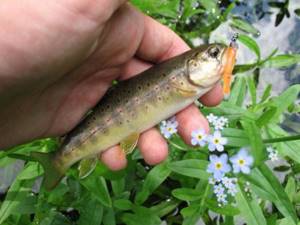
Since all types of trout cannot tolerate dirty water, they leave their “hibernation” upon the onset of floods.
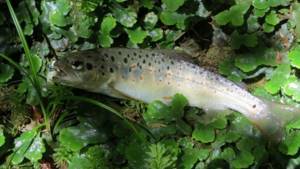
Adult, self-sufficient individuals live alone, near waterfalls and streams. In general, wherever the peace will not be disturbed.
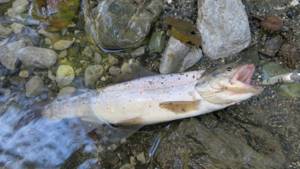
Young animals, on the contrary, gather in schools and spend their summer holidays traveling. It can be found in algae because there are a lot of nutrients there.

Rainbow trout habitats
Fishermen will also be interested in knowing where rainbow trout are found. The fact is that this species is practically never found in the wild in our country. The original habitats of wild rainbow trout are freshwater rivers and lakes off the coast of the Pacific Ocean in North America.
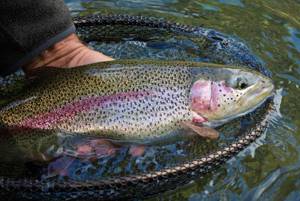
This species was also artificially introduced into the waters of New Zealand, Japan, and Australia. This fish can also be found in South Africa.
In European countries, as well as in Russia, this species is actively bred for commercial fishing. For this purpose, artificial ponds with clean and cold water are created. This species thrives in water whose temperature does not exceed 20ºС.
Rainbow trout do not like bright light. She prefers to hide in the shadows. The fish becomes active in cloudy weather, as well as in the morning and evening hours. The reservoir in which this type of fish lives should not be closed and small. In winter it should not be covered with ice. Periodically, the trout rises to the surface to take air into its swim bladder.
The nutritional value
The beneficial properties of such fish have long been known. Thanks to its powerful composition of vitamins, fatty acids and microelements, it is an irreplaceable product on our tables.
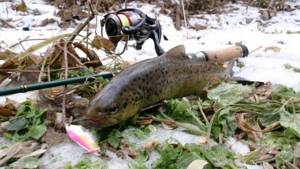
And the taste properties are noted not only by real gourmets, but also by a connoisseur of such a product - the bear.
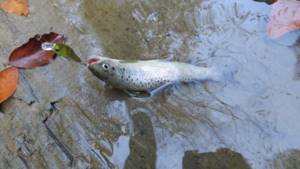
The small amount of calories allows it to be used in various diets. And the most important feature is the prevention of cancer.
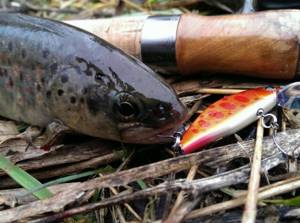
It is also good for students and for diseases of the nervous system.
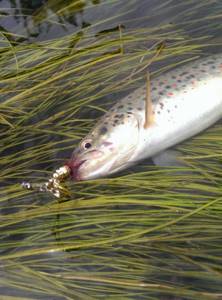
Trout farming
Commercial fishing has become popular in recent years. For this purpose, an artificial reservoir is created into which trout and other species of fish are periodically released. Most often in our country you can find carp and rainbow trout in such ponds.
Another species is also bred in Irkutsk. This is an amber trout. It will not be difficult to determine where this fish is found. Its main breeding site is the area near Babr Island. In the Angara reservoirs below the dam of the local hydroelectric power station, entrepreneurs began to actively breed this type of trout. You can come here for fishing both in winter and in summer.
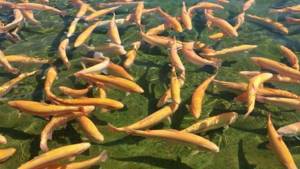
Amber trout are caught using a fishing rod or even just a net. Fresh fish differs significantly in taste from the trout that is presented on store shelves. It is brought to our country from Scandinavia. Long-term transportation affects the quality of trout. Therefore, catching fresh fish is not only interesting, but also useful.
